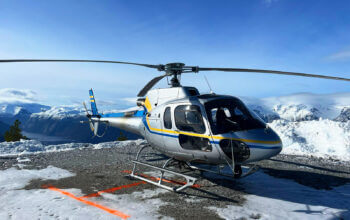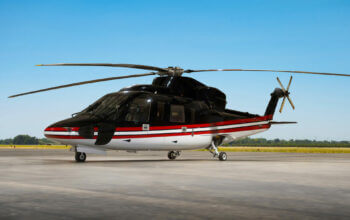Estimated reading time 12 minutes, 12 seconds.
The federal government on Nov. 30 ended weeks of political wrangling with an announcement that it has finalized an agreement with the United States government to acquire up to 16 Boeing P-8A Poseidon multi-mission aircraft to replace the Royal Canadian Air Force (RCAF) fleet of CP-140 Aurora maritime patrol aircraft.
The US$5.9 billion deal includes 14 aircraft, with options for up to two more, as well as associated equipment, training devices, and initial sustainment. In total, the government expects to spend C$10.4 billion on the new fleet, training system, advanced weapons, and upgrades to infrastructure at the long-range patrol community’s two main operating bases — 14 Wing Greenwood, N.S., and 19 Wing Comox, B.C.
The government had faced mounting pressure from opposition parties and companies across the aerospace and defence sectors to hold an open competition for what is known as the Canadian Multi-Mission Aircraft (CMMA) project. In presentations to a Parliamentary committee and in meetings with government officials, Montreal-based Bombardier and its partners contended they could deliver a Canadian-built solution, under cost and within schedule, to meet the RCAF’s core requirements.

Their campaign, based on a special mission variant of the Global 6500, became more vocal and visible after March 2023 when Public Services and Procurement Canada (PSPC) issued a letter of request (LOR) to the U.S. government for the acquisition price of 16 P-8s, after conducting a market analysis and gathering industry input in 2021 and 2022. The P-8A “is the only currently available aircraft that meets all of the operational requirements,” PSPC stated at the time.
Ministers and senior government officials reaffirmed that belief during a press conference and technical briefing on Thursday.
The Poseidon “meets all of the [RCAF’s] operational requirements and is the only currently available aircraft,” said Jean-Yves Duclos, Minister of PSPC, in explaining the sole-source contract through a foreign military sale.
The CP-140 fleet will have operated almost 50 years by the time it reaches the end of its service life in 2030, and “we believe it is very much in the public and national interest to acquire the only capability currently available to us,” added Bill Blair, Minister of National Defence.
The P-8A specializes in anti-submarine and anti-surface warfare, he noted, and “can detect, identify, and track threats using sophisticated sensors and weapons, while defending itself from potential threats. These aircraft are not just planes, they are complex weapon systems. And the Poseidon is a proven capability with a track record of success.”
While the CP-140 has been a leading submarine hunter and intelligence, surveillance, and reconnaissance gathering platform since it was acquired in 1980 — conducting Arctic patrols, counter narcotics operations, and United Nations sanctions monitoring of North Korea, among other missions — it is rapidly showing its age.
“The Aurora is becoming increasingly difficult to support, expensive to sustain, and less suited to operating in today’s threat environment,” said Blair. Adversaries, including Russia and China, “have been deploying increasingly sophisticated, stealthy, and lethal capabilities, and therefore the Aurora must be replaced.”
During the technical briefing, senior air force officers said their ability to employ the CP-140 was “deteriorating due to technical obsolescence and an increasing operational gap measured against the capabilities of our potential adversaries.”
Although the fleet has undergone an incremental modernization project over the past 20 years to upgrade communication and navigation systems, mission systems, sensors, datalinks, and self-defence capabilities, as well as some structural components, problems with “mechanical systems such as the engines and propellers, as well as its operational mission systems,” make the aircraft difficult to maintain.
“Age and the dated concept of operations on which [the CP-140] was originally designed preclude further upgrades to address operational deficiencies, including the ability to operate effectively in modern threat environments,” the senior officers said.
The P-8, a militarized variant of the Boeing 737NG, is operated by all of Canada’s Five Eyes allies — the United States, United Kingdom, Australia, and New Zealand — as well as Norway and South Korea. And Germany is expecting its first aircraft in October 2024. With over 160 P-8s delivered and more than 560,000 flying hours under their wings, the RCAF intends to capitalize on the tactics, techniques, and procedures already developed, the officers said.
Norway, in particular, could be a source for best practices in Arctic operations, they noted.
Blair and the Air Force officers raised the more frequent and aggressive intercepts by Chinese fighter jets of Auroras monitoring the shipping lanes of the East China Sea in the past year, and the persistent presence of advanced submarines, as part of a change threat environment.
The CP-140’s “ability to defend itself is somewhat limited,” said Blair, adding that one of the high-level operational requirements for CMMA is increasing defensive capabilities.
The P-8A sensor suite is far more advanced than the Auora, with the ability to detect “the latest submarines and surface ships,” the RCAF officers said. It also has a communications system “with one hundred times the bandwidth than we currently have on the CP-140.”
The Aurora’s static passive sonobuoy system will be replaced by a multi-static active array system able to triangulate much quieter subs and in far larger volumes of water, said one officer. And crews will be able to hand over tracks to allies using the same system. “That is the difference maker for this aircraft,” he said of the P-8A. “The fact that we are all on the same modality of anti-submarine warfare is extremely important from an operational advantage point of view.”
The Poseidon will be capable of air-to-air refueling from the soon to be converted CC-330 Husky, giving it time on station only limited by crew rest requirements.
Ministers and senior officials were challenged about opting to pass over a Canadian-built platform for the P-8A, and the economic benefits that might ensue. As part of its campaign, Bombardier highlighted a PricewaterhouseCoopers report, released in July 2023, that concluded a Canadian-built Global 6500 variant would generate an economic return of about $2.8 billion in GDP, 22,650 full-time equivalent jobs, and $1.8 billion in labour income.
François-Philippe Champagne, Minister of Innovation, Science and Industry, insisted that the Boeing proposal “will not only create good jobs, but also help grow our domestic aerospace industry. Boeing will be making strategic investments with leading Canadian firms and has also committed to growing its presence in Canada through further investments.”
The P-8 contract has the potential to generate more than 3,000 jobs annually and contribute at least $358 million annually in GDP over a 10-year period, the government stated.
Boeing’s Team Poseidon consists of CAE, GE Aviation Canada, IMP Aerospace & Defence, KF Aerospace, Honeywell Aerospace Canada, Raytheon Canada, and StandardAero, and already draws on 81 Canadian suppliers for the P-8 platform.
“This is a very important day for the Royal Canadian Air Force and for Boeing,” said Charles “Duff” Sullivan, managing director of Boeing Canada. “The P-8 offers unmatched capabilities and is the most affordable solution for acquisition and life-cycle sustainment costs.”
Champagne said Boeing will invest $5.4 billion, the equivalent of the aircraft acquisition contract, in Canadian industry over a 10-year period, integrating Canadian companies into its global supply chain, developing green technology, supporting skills training, and partnering with university research programs. Boeing has also plans to establish an innovation centre in Montreal.
“We will be monitoring this very closely,” said Champagne.
In a statement, Bombardier said it was disappointed that the Canadian government “has decided to award a generational contract without an open and fair competition, and without fully evaluating its home-grown industry’s multi-mission aircraft capabilities.
“Despite multiple conversations with the government, where we requested an RFP or a more detailed framework within which to present key facts and capabilities, no such follow-on opportunities were given to Bombardier, or its partners. No aerospace or third-party experts subsequently evaluated our capabilities.”
Bombardier added: “There is still a bright future for maritime surveillance platforms that Bombardier [intends] to offer Canada and the rest of world, which will be less expensive to acquire, less expensive to operate, saving approximately 30 per cent on operating costs, all while decreasing carbon emission by approximately 40 per cent. . . . We are confident that our product offering will be successful in multiple markets, setting a new standard for maritime patrol.”
Champagne noted the government’s concern about timelines and Bombardier’s ability to have an aircraft on the ramp before the CP-140 is withdrawn from service. But he pledged to “continue to work with Bombardier” to open other opportunities for their militarized aircraft. “We believe in their capacity.”
The first P-8A is expected in 2026, followed by about one a month until the fall of 2027. Full operational capability is anticipated for 2033. The only Canadian modification will be the paint scheme.









Finally, a timely acquisition of a platform that is massively important to the strategic defence of our nation based on operational instead of political factors. This purchase will allow for a seamless transition to a superior capability with minimal disruption. Interesting how Bombardier appeared with their hand out and tried to force their way into the replacement with only a concept to offer. It will take a minimum of a decade to produce their prototype with the necessary modifications and integration of the weapons and surveillance systems at which point it’s very likely that their range, speed and operational capabilites will be degraded by the aerodynamic changes required. Bombardier business development failed to come up with an actual product to compete with. The Aurora replacement requirement was well known by all but of course they would not want to commit their own money when they could hose the federal government for the development costs. THEN they could offer their aircraft to foreign countries with a product subsidized by the Canadian taxpayer. Looking forward to seeing this aircraft in a couple of years and again, glad to see an acquisition process be executed in a capable manner for a change. Now, let’s get serious about the Victoria Class submarine replacement program.
This reply couldn’t have been better said. Bombardier was only looking for handouts and show the world the hatred it has for Boeing. Why didn’t they offer the a220 if they were remotely serious?
Bombardier has no relationship to the A220 anymore. The program is 75% Airbus and 25% Investissement Québec. The Global is the largest aircraft they manufacture.